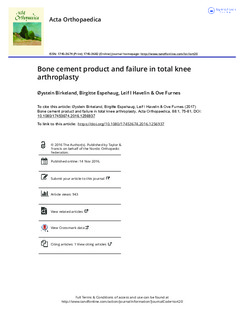| dc.contributor.author | Birkeland, Øystein | |
| dc.contributor.author | Espehaug, Birgitte | |
| dc.contributor.author | Havelin, Leif Ivar | |
| dc.contributor.author | Furnes, Ove | |
| dc.coverage.spatial | Norway | nb_NO |
| dc.date.accessioned | 2019-05-28T06:49:19Z | |
| dc.date.available | 2019-05-28T06:49:19Z | |
| dc.date.created | 2018-01-16T09:37:10Z | |
| dc.date.issued | 2017 | |
| dc.identifier.citation | Birkeland, Ø., Espehaug, B., Havelin, L. I., & Furnes, O. (2016). Bone cement product and failure in total knee arthroplasty. Acta Orthopaedica, 88(1), 75-81. | nb_NO |
| dc.identifier.issn | 1745-3674 | |
| dc.identifier.uri | http://hdl.handle.net/11250/2599091 | |
| dc.description.abstract | Background and purpose — The bone cement market for total knee arthroplasty (TKA) in Norway has been dominated by a few products and distributors. Palacos with gentamicin had a market share exceeding 90% before 2005, but it was then withdrawn from the market and replaced by new slightly altered products. We have compared the survival of TKAs fixated with Palacos with gentamicin with the survival of TKAs fixated with the bone cements that took over the market.
Patients and methods — Using data from the Norwegian Arthroplasty Register for the period 1997–2013, we included 26,147 primary TKAs in the study. The inclusion criteria were TKAs fixated with the 5 most used bone cements and the 5 most common total knee prostheses for that time period. 6-year Kaplan-Meier survival probabilities were established for each cement product. The Cox proportional hazards regression model was used to assess the association between bone cement product and revision risk. Separate analyses were performed with revision for any reason and revision due to deep infection within 1 year postoperatively as endpoints. Adjustments were made for age, sex, diagnosis, and prosthesis brand.
Results — Survival was similar for the prostheses in the follow-up period, between the 5 bone cements included: Palacos with gentamicin, Refobacin Palacos R, Refobacin Bone Cement R (Refobacin BCR), Optipac Refobacin Bone Cement R (Optipac Refobacin BCR), and Palacos R + G.
Interpretation — According to our findings, the use of the new bone cements led to a survival rate that was as good as with the old bone cement (Palacos with gentamicin). | nb_NO |
| dc.language.iso | eng | nb_NO |
| dc.publisher | Taylor & Francis | nb_NO |
| dc.rights | Navngivelse-Ikkekommersiell 4.0 Internasjonal | * |
| dc.rights.uri | http://creativecommons.org/licenses/by-nc/4.0/deed.no | * |
| dc.title | Bone cement product and failure in total knee arthroplasty : A follow-up study of 26,147 knee replacements between 1997 and 2013 in Norway | nb_NO |
| dc.type | Journal article | nb_NO |
| dc.type | Peer reviewed | nb_NO |
| dc.description.version | publishedVersion | nb_NO |
| dc.rights.holder | © 2016 The Author(s). | nb_NO |
| dc.subject.nsi | VDP::Medisinske Fag: 700::Klinisk medisinske fag: 750::Reumatologi: 759 | nb_NO |
| dc.source.pagenumber | 75-81 | nb_NO |
| dc.source.volume | 88 | nb_NO |
| dc.source.journal | Acta Orthopaedica | nb_NO |
| dc.source.issue | 1 | nb_NO |
| dc.identifier.doi | 10.1080/17453674.2016.1256937 | |
| dc.identifier.cristin | 1543702 | |
| cristin.unitcode | 203,3,20,0 | |
| cristin.unitname | Senter for kunnskapsbasert praksis - Bergen | |
| cristin.ispublished | true | |
| cristin.fulltext | original | |
| cristin.qualitycode | 1 | |

